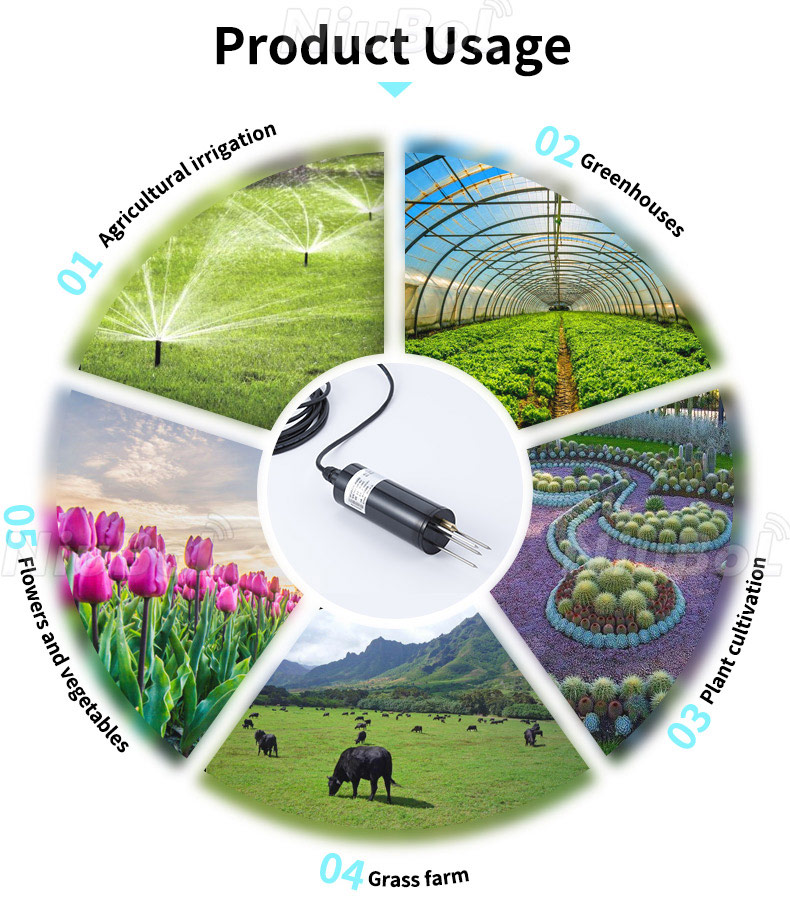

— Products —
 Consumer hotline +8618073152920
Consumer hotline +8618073152920 WhatsApp:+8615367865107
Address:Room 102, District D, Houhu Industrial Park, Yuelu District, Changsha City, Hunan Province, China
All products
Soil temperature sensors are devices used to measure soil temperature and operate on the basis of the thermoelectric effect or the property of resistance to change with temperature. Specifically, commonly used soil temperature sensors include thermocouple sensors and thermistor sensors. usually need to be connected to a signal processing circuit in order to convert the electrical signal output from the sensor into a temperature value. In this way, soil temperature sensors are···
Tel/WhatsApp:+8615367865107
Email:Arvin@niubol.com +Nearly 100 partner companies in more than 68 countries. We are committed to providing high-quality, practical products to meet your needs and help you solve problems. Our products comply with international standards and are certified with ISO, CE and RoHS.Product Details





Soil temperature sensors are devices used to measure soil temperature and operate on the basis of the thermoelectric effect or the property of resistance to change with temperature. Specifically, commonly used soil temperature sensors include thermocouple sensors and thermistor sensors.
These sensors usually need to be connected to a signal processing circuit in order to convert the electrical signal output from the sensor into a temperature value. In this way, soil temperature sensors are able to monitor temperature changes in the soil in real time, providing critical data for agricultural production, environmental monitoring, and other fields.
1. Sensing Element:The sensor contains a temperature sensitive element, usually a resistance temperature detector (RTD), thermistor or thermocouple. The choice of material depends on the required accuracy, response time and the operating temperature range of the sensor.
2. Construction:The sensing element is usually encased in a material that allows it to come into direct contact with the soil, such as a cable with a probe that is inserted into the soil to a desired depth. The probe is usually made of a material that is resistant to the soil environment.
3. Electronic circuitry: Electronic circuitry converts the resistance or voltage of a temperature-sensitive element into a reading that corresponds to the soil temperature. This conversion may involve amplification, filtering and calibration to ensure an accurate temperature reading.
4. Data Output:The sensor can provide outputs in a variety of forms, such as analog (e.g., 4-20mA), digital (e.g., SDI12, RS485 Modbus), or wireless (e.g., LoRa) signals. The choice of output depends on the user's needs and the system with which it is combined.
5. Power requirements:The sensors require an external power supply, or they use batteries or solar power.
6. Temperature range and accuracy: The specification of the sensor will define the temperature range it can measure -40°C to 80°C and the accuracy of these measurements (±0.5°C, ±1°C, etc.).
7. Environmental Resistance:The sensor should be designed to withstand the environmental conditions of the soil, including moisture, chemicals and biological agents, without degradation of performance.
8. Installation and Maintenance: Sensors may need to be installed at specific depths in the soil and may require periodic maintenance to ensure continued accurate operation.

Soil temperature sensors have a wide range of application scenarios and applications in several fields.
Firstly, in the field of agriculture, soil temperature sensors play a vital role. It can be used to monitor the growth of crops and help farmers get a better grasp of crop growth so that they can adjust irrigation, fertilization and other management measures to improve crop yield and quality. By monitoring soil temperature in real time, farmers can understand soil conditions more accurately and develop more scientific planting plans.
Secondly, soil temperature sensors are also widely used in the field of environmental monitoring. It can monitor the temperature inside and on the surface of the soil in real time and upload the data to the cloud or database, helping environmental monitors to better understand the temperature change pattern of the soil, so as to more accurately assess the thermal environment of the soil and the health of the ecosystem. This is of great significance for the protection of the ecological environment and the maintenance of ecological balance.
In addition, the soil temperature sensor also plays an important role in forestry, animal husbandry, urban construction and environmental protection. In the field of forestry, it can be used to monitor the health of forests; in the field of animal husbandry, it can help people better grasp the health of animals; in the field of urban construction and environmental protection, it can provide a scientific basis for urban planning and environmental protection.
Soil temperature sensors can also be used in combination with other types of sensors (such as humidity sensors) to provide more comprehensive information about the soil environment. Together, these sensors can form a soil monitoring system for real-time monitoring of soil temperature, humidity and other parameters to provide decision support for agricultural production.
Overall, soil temperature sensors are an important agricultural and environmental monitoring device, and they are an important tool for agriculture, horticulture, and environmental monitoring because soil temperature affects the growth and health of plants, the activity of soil organisms, and the cycling of nutrients.
NBL-S-THR-Soil-temperature-and-moisture-sensors-Instruction-Manual-V4.0.pdf
Sensors & Weather Stations Catalog
Agriculture Sensors and Weather Stations Catalog-NiuBoL.pdf
Weather Stations Catalog-NiuBoL.pdf
Related recommendations
 Multi-Depth Soil Sensor RS485
Multi-Depth Soil Sensor RS485 TDR Soil Moisture Sensor
TDR Soil Moisture Sensor Pyranometer Solar Radiation Sensors
Pyranometer Solar Radiation Sensors Soil ph sensor
Soil ph sensor Tipping Bucket Rain Gauge
Tipping Bucket Rain Gauge Air Temperature and Humidity Sensor
Air Temperature and Humidity Sensor
Screenshot, WhatsApp to identify the QR code
WhatsApp number:+8615367865107
(Click on WhatsApp to copy and add friends)
